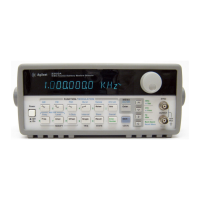Command Separators
A colon ( : ) is used to separate a command keyword from a lower-level
keyword. You must insert a blank space to separate a parameter from a
command keyword. If a command requires more than one parameter,
you must separate adjacent parameters using a comma as shown below:
"APPL:SIN 5 KHZ, 3.0 VPP, -2.5 V"
A semicolon ( ; ) is used to separate commands within the same
subsystem, and can also minimize typing. For example, sending the
following command string:
"FREQ:START 10; STOP 1000; MODE SWEEP"
... is the same as sending the following three commands:
"FREQ:START 10"
"FREQ:STOP 1000"
"FREQ:MODE SWEEP"
Use a colon and a semicolon to link commands from different subsystems.
For example, in the following command string, an error is generated if
you do not use both the colon and semicolon:
"SWE:STAT ON;:TRIG:SOUR EXT"
Using the MIN and MAX Parameters
You can substitute MINimum or MAXimum in place of a parameter for
many commands. For example, consider the following command:
FREQuency {<frequency>|MINimum|MAXimum}
Instead of selecting a specific frequency, you can substitute MIN to set
the frequency to its minimum value or MAX to set the frequency to its
maximum value.
4
Chapter 4 Remote Interface Reference
An Introduction to the SCPI Language
213

